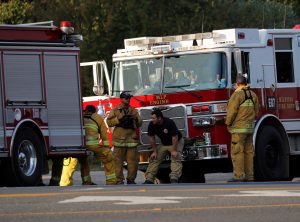
By Phil Stewart
WASHINGTON (Reuters) – The United States believes Iran has started carrying out naval exercises in the Gulf, apparently moving up the timing of annual drills amid heightened tensions with Washington, U.S. officials told Reuters on Thursday.
One U.S. official, speaking on condition of anonymity, said possibly more than 100 vessels were involved in the drills, including small boats. A second official expected the drill could be wrapped up this week.
Iran has been furious over U.S. President Donald Trump’s decision to pull out of an international nuclear deal and reimpose sanctions on Tehran. Senior Iranian officials have warned the country would not easily yield to a renewed U.S. campaign to strangle Iran’s vital oil exports.
The U.S. military’s Central Command on Wednesday confirmed it has seen an increase in Iranian naval activity, including in the Strait of Hormuz, a strategic waterway for oil shipments that Iran’s Revolutionary Guards have threatened to block.
“We are monitoring it closely, and will continue to work with our partners to ensure freedom of navigation and free flow of commerce in international waterways,” said Navy Captain Bill Urban, the chief spokesman at Central Command, which oversees U.S. forces in the Middle East.
Central Command did not update its guidance on Thursday.
A third official said the Iranian naval operations did not appear to be affecting commercial maritime activity.
U.S. officials, speaking to Reuters on condition of anonymity, said the drills appeared designed to send a message to Washington, which is intensifying its economic and diplomatic pressure on Tehran but so far stopping short of using the U.S. military to more aggressively counter Iran and its proxies.
But Iran did not appear interested in drawing attention to them. Iranian authorities have yet to comment on them and several officials contacted by Reuters declined to comment.
Trump’s policies are already putting significant pressure on the Iranian economy, although U.S. intelligence suggests they may ultimately rally Iranians against the United States and strengthen Iran’s hardline rulers, officials say.
Iran’s currency plumbed new depths this week ahead of Aug. 7, when Washington is due to reimpose a first lot of sanctions following Trump’s withdrawal from the 2015 nuclear deal.
Protests have broken out in Iran since the beginning of the year over high prices, water shortage, power cuts and alleged corruption.
On Tuesday, hundreds of people rallied in cities including Isfahan, Karaj, Shiraz and Ahvaz to protest high inflation caused in part by the weak rial.
(Reporting by Phil Stewart in Washington; additional reporting by Parisa Hafezi in Ankara; Editing by James Dalgleish)











